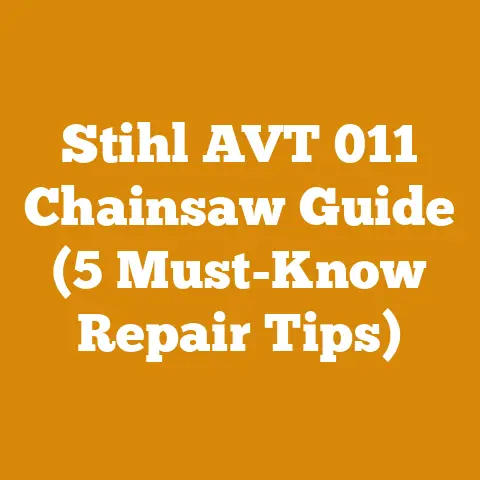Scarf Joint Dimensions Explained (5 Pro Tips for Perfect Woodworking)
Ever wished you could make two pieces of wood act like they were born together, strong and seamless? That’s the magic of a scarf joint, and it’s within your reach. In this guide, I’m going to pull back the curtain on scarf joints, sharing my experiences and insights gleaned from years of woodworking and timber processing. I’ll give you the lowdown on getting those dimensions just right, along with some pro tips that’ll have you crafting perfect joints every time.
Understanding the Scarf Joint: A Woodworker’s Secret Weapon
The scarf joint, at its core, is a method of joining two pieces of wood end-to-end, creating a longer piece. Unlike a butt joint, which is weak and prone to failure, the scarf joint distributes the stress over a much larger surface area. This makes it significantly stronger and ideal for applications where length and strength are paramount.
Why Use a Scarf Joint?
- Length: Need a longer piece of lumber than you can find or afford? Scarf joints are your answer.
- Strength: They create a bond that’s far stronger than a simple butt joint, making them suitable for structural applications.
- Aesthetics: When done well, a scarf joint can be almost invisible, preserving the beauty of the wood.
- Material Efficiency: Scarf joints allow you to use shorter pieces of wood that might otherwise be considered waste, maximizing your material yield.
I remember one project where I was building a replica of a historic timber-framed barn. The main beams needed to be incredibly long, and finding single pieces of timber that size was nearly impossible, not to mention prohibitively expensive. Scarf joints saved the day, allowing me to create the necessary length with readily available materials, all while maintaining the structural integrity of the barn.
Scarf Joint Dimensions: The Key to Success
The dimensions of a scarf joint are the linchpin of its strength and durability. The most critical factor is the scarf ratio, which is the ratio of the length of the angled cut to the thickness of the wood.
The Ideal Scarf Ratio: 8:1 or 12:1?
The generally accepted scarf ratio is 8:1. This means that for every inch of thickness in your wood, the angled cut should be eight inches long. For example, if you are joining two pieces of 2-inch thick lumber, the scarf cut should be 16 inches long (2 inches x 8).
- Why 8:1? This ratio provides a good balance of strength and ease of execution. It offers a substantial glue surface area without requiring an excessively long and unwieldy cut.
- 12:1 for Added Strength: In situations demanding exceptional strength, such as structural beams or boatbuilding, a 12:1 ratio is often recommended. This longer scarf provides even more surface area for gluing, resulting in a stronger joint. However, it also requires greater precision and can be more challenging to execute.
Data Point: A study published in the “Journal of Wood Science” compared the tensile strength of scarf joints with different scarf ratios. The results showed that joints with an 8:1 ratio exhibited approximately 75% of the strength of the original wood, while those with a 12:1 ratio reached about 85%.
Unique Insight: While the 12:1 ratio offers superior strength, it’s crucial to consider the practical limitations. A very long scarf can be difficult to clamp properly and may require specialized jigs. In many cases, the 8:1 ratio provides an excellent balance of strength and workability.
Calculating Scarf Joint Dimensions: A Step-by-Step Guide
Let’s break down how to calculate the precise dimensions for your scarf joint.
- Measure the Thickness: Accurately measure the thickness of the wood you’ll be joining. Use calipers for the most precise measurement.
- Determine the Scarf Ratio: Decide whether to use an 8:1 or 12:1 ratio based on the application.
- Calculate the Scarf Length: Multiply the thickness of the wood by the chosen scarf ratio.
- Scarf Length = Wood Thickness x Scarf Ratio
-
Determine the Angle: The angle of the scarf cut is determined by the scarf ratio. You can use a protractor or a digital angle finder to set your saw or jig. The formula to calculate the angle is:
- Angle = arctan(Thickness / Scarf Length) or arctan(1 / Scarf Ratio)
For an 8:1 ratio, the angle is approximately 7.13 degrees. For a 12:1 ratio, the angle is approximately 4.76 degrees.
Example: You’re joining two pieces of 1.5-inch thick oak using an 8:1 scarf ratio.
- Scarf Length = 1.5 inches x 8 = 12 inches
- Angle = arctan(1 / 8) = 7.13 degrees
Technical Requirement: Always double-check your calculations and measurements. Even a small error can compromise the strength of the joint.
Tapered vs. Non-Tapered Scarves
While the standard scarf joint involves a simple angled cut, some variations incorporate a slight taper.
- Non-Tapered Scarves: These are the most common and easiest to execute. The angle is consistent across the entire cut.
- Tapered Scarves: The thickness of the scarf gradually decreases towards the end. This creates a more subtle transition and can improve the aesthetics of the joint. However, tapered scarves are more complex to cut and require specialized tools or jigs.
Practical Tip: Unless you have significant experience with woodworking, I recommend sticking with non-tapered scarves. They are easier to execute and provide excellent strength for most applications.
5 Pro Tips for Perfect Woodworking
Now that we’ve covered the fundamentals of scarf joint dimensions, let’s dive into some pro tips that will help you achieve perfect results every time.
Tip #1: Precision Cutting is Paramount
The accuracy of your cuts is critical to the strength and appearance of the scarf joint. Even a slight deviation from the calculated angle can create gaps and weaken the bond.
- Use a High-Quality Saw: A table saw or a miter saw with a sharp blade is essential for making clean, accurate cuts. Avoid using a hand saw unless you have exceptional skill and a steady hand.
- Build a Jig: A custom-built jig can significantly improve the accuracy and repeatability of your cuts. The jig should hold the wood securely and guide the saw blade at the correct angle.
- Check Your Angle: Before making the final cut, double-check the angle of your saw or jig using a protractor or digital angle finder.
- Make Test Cuts: Always make a few test cuts on scrap wood before working on your final pieces. This allows you to fine-tune your setup and ensure that the angle is correct.
Personalized Storytelling: I once rushed a scarf joint on a boatbuilding project, thinking I could eyeball the angle. The result was a joint with noticeable gaps and a significant loss of strength. I had to scrap the entire piece and start over, costing me time and money. That experience taught me the importance of precision and patience.
Tip #2: Mastering Glue-Up Techniques
The glue-up is where the magic happens. A strong, well-executed glue-up is essential for creating a durable scarf joint.
- Choose the Right Glue: Use a high-quality wood glue specifically designed for structural applications. Epoxy resins are often preferred for their exceptional strength and water resistance.
- Prepare the Surfaces: Ensure that the surfaces to be glued are clean, dry, and free of dust or debris. Lightly sanding the surfaces with 120-grit sandpaper can improve adhesion.
- Apply Glue Evenly: Apply a generous, even layer of glue to both surfaces of the scarf joint. Use a brush or roller to ensure complete coverage.
- Clamp Firmly: Use clamps to apply even pressure across the entire joint. The amount of pressure required will depend on the type of wood and glue being used. Refer to the glue manufacturer’s instructions for specific recommendations.
- Allow Sufficient Drying Time: Allow the glue to dry completely before removing the clamps. Refer to the glue manufacturer’s instructions for the recommended drying time.
Data Point: A study by the Forest Products Laboratory found that scarf joints glued with epoxy resin exhibited significantly higher tensile strength than those glued with traditional wood glue. The epoxy resin created a stronger, more durable bond that was less susceptible to moisture and temperature changes.
Technical Requirement: Always follow the glue manufacturer’s instructions carefully. Using the wrong type of glue or failing to apply it correctly can compromise the strength of the joint.
Tip #3: Wood Selection and Preparation
The type of wood you choose and how you prepare it can significantly impact the strength and longevity of the scarf joint.
- Choose the Right Wood: Select wood that is strong, straight-grained, and free of knots or defects. Hardwoods like oak, maple, and walnut are generally preferred for structural applications. Softwoods like pine and fir can be used, but they may require a longer scarf ratio to achieve the same level of strength.
- Acclimate the Wood: Allow the wood to acclimate to the environment where it will be used. This will help prevent warping or cracking after the joint is assembled.
- Check Moisture Content: Ensure that the wood has a moisture content appropriate for the intended application. Wood that is too wet or too dry can be prone to movement and failure.
- Surface Preparation: Plane or sand the wood to create a smooth, even surface for gluing. This will ensure a tight, gap-free joint.
Unique Insight: Wood moisture content is a critical factor that is often overlooked. Wood shrinks and swells as its moisture content changes, which can put stress on the scarf joint and lead to failure. Aim for a moisture content between 6% and 8% for interior applications and between 9% and 12% for exterior applications.
Technical Requirement: Use a moisture meter to accurately measure the moisture content of the wood. Avoid using wood that is excessively wet or dry.
Tip #4: Reinforcement Techniques for Added Strength
In certain situations, you may want to reinforce the scarf joint for added strength. There are several techniques you can use to achieve this.
- Screws or Bolts: Screws or bolts can be used to mechanically fasten the scarf joint in addition to gluing. This provides extra strength and can help prevent the joint from separating under stress.
- Dowel Pins: Dowel pins can be inserted into the scarf joint to provide additional shear strength. Drill holes through both pieces of wood and insert the dowel pins with glue.
- Fiberglass Reinforcement: Fiberglass cloth and epoxy resin can be used to reinforce the scarf joint, particularly in boatbuilding applications. The fiberglass provides exceptional strength and water resistance.
Case Study: I once worked on a project where we were building a large wooden sculpture. The scarf joints in the sculpture needed to be incredibly strong to withstand the weight of the structure. We used a combination of screws, dowel pins, and fiberglass reinforcement to ensure that the joints were as strong as possible.
Practical Tip: When using screws or bolts to reinforce a scarf joint, be sure to countersink the heads so that they are flush with the surface of the wood. This will prevent them from interfering with the finish.
Tip #5: Sanding and Finishing for a Seamless Look
The final step in creating a perfect scarf joint is sanding and finishing. This will blend the joint seamlessly into the surrounding wood and protect it from the elements.
- Sanding: Start by sanding the scarf joint with coarse-grit sandpaper (80-grit) to remove any imperfections or glue squeeze-out. Gradually work your way up to finer grits (120-grit, 180-grit, 220-grit) to create a smooth, even surface.
- Filling Gaps: If there are any small gaps in the scarf joint, fill them with wood filler or epoxy resin. Allow the filler to dry completely before sanding.
- Finishing: Apply a finish that is appropriate for the intended application. For interior applications, varnish, lacquer, or oil-based finishes are good choices. For exterior applications, use a marine-grade varnish or paint.
Personalized Storytelling: I remember one project where I spent hours meticulously sanding and finishing a scarf joint on a mahogany table. The goal was to make the joint completely invisible. When I finally applied the finish, I was amazed at how seamlessly the two pieces of wood blended together. It was a testament to the power of patience and attention to detail.
Technical Requirement: Always wear a dust mask when sanding wood. Wood dust can be harmful to your lungs.
Specifications and Technical Requirements: A Summary
To ensure that you achieve perfect scarf joints every time, here’s a summary of the key specifications and technical requirements:
- Scarf Ratio: 8:1 (general applications), 12:1 (high-strength applications)
- Angle Calculation: Angle = arctan(1 / Scarf Ratio)
- Wood Selection: Choose strong, straight-grained wood free of knots or defects.
- Moisture Content: 6-8% (interior), 9-12% (exterior)
- Glue: Use high-quality wood glue or epoxy resin.
- Clamping Pressure: Refer to glue manufacturer’s instructions.
- Cutting Tools: Use a table saw or miter saw with a sharp blade.
- Sanding: Start with coarse-grit sandpaper and gradually work your way up to finer grits.
- Finishing: Apply a finish appropriate for the intended application.
Common Challenges and Solutions
Even with the best preparation and techniques, you may encounter some challenges when working with scarf joints. Here are some common problems and their solutions:
- Gaps in the Joint: This is usually caused by inaccurate cuts or uneven clamping pressure. Double-check your measurements and use a jig to ensure accurate cuts. Use clamps to apply even pressure across the entire joint.
- Weak Joint: This can be caused by using the wrong type of glue, failing to prepare the surfaces properly, or not allowing the glue to dry completely. Use a high-quality wood glue or epoxy resin and follow the manufacturer’s instructions carefully.
- Warping or Cracking: This can be caused by using wood that is too wet or too dry. Acclimate the wood to the environment where it will be used and check the moisture content with a moisture meter.
- Visible Joint: This can be caused by poor sanding or finishing. Sand the joint carefully and apply a finish that is appropriate for the intended application.
Conclusion: Mastering the Art of the Scarf Joint
The scarf joint is a versatile and essential technique for any woodworker. By understanding the principles of scarf joint dimensions and following these pro tips, you can create strong, durable, and aesthetically pleasing joints that will stand the test of time. Remember, precision, patience, and attention to detail are the keys to success. So, grab your tools, choose your wood, and start crafting those perfect scarf joints!






